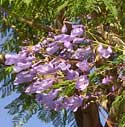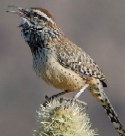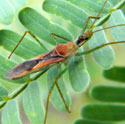May
May 7 2011: Jacaranda trees are, understandably, very popular garden trees in Phoenix and other tropical and subtropical cities. Plenty of shade below huge sprays of bright lilac-blue flowers. Brought into cultivation from wild progenitors in Brazil and Paraguay, many horticultural versions may be hybrids of two or more species. As exotics their ecosystem associates, i.e. bees and plant-chewing insects are absent on these plants in my neighbor's garden. Myself, I'd rather not grow this plant because it offers little for the birds and other wildlife that I want to attract to my garden. Instead I insist that only native plants grow in my garden.
May 17 2003: An adult female Verdin brought a new fledgling Verdins by my little yard for a visit. Mom was busy catching little mirid bugs from the blue palo verde to feed the youngster while at the same time teaching: "Find food here ... pay attention ... soon you'll have to find your own. AND don't forget to watch for somebody that wants to eat you up!"
May 16 2003: The Soapberry Tree is just beginning to bloom. In a few days thousands of pale cream-colored flowers each less than 3 mm across and apparently endowed with an abundance of sweet nectar will be open. Hundreds of bees including Alkali Bees (Nomia melanderi), sweat bees (two species), yellow-faced bees (Hylaeus spp. - two species), Honey Bees and leaf-cutter bees (Megachile two species) will swarm about. To spoil the bees' picnic Forelius ants by the thousands ascend the tree every morning by 7 am. They enter the flowers and remove much of the available pollen and nectar. Not all the bees are after flowers. Male alkali and leaf-cutters are madly cruising from inflorescence to inflorescence, looking for females while attempting to chase off any other males. Because female leaf cutter bees' nests are not clustered together the way Carpenter Bees nests are (see below) this is the best way for the males to encounter females; mostly the female bees aren't at all interested and must keep avoiding suitors if they're going to get their pollen gathering done. The same activity can be seen about Lantana Bushes. For anyone growing fruits in their urban Phoenix gardens, these bees are vital for pollination and fruit set.
May 13 2003: Today I added a new species of bird to my yard list: Lesser Nighthawk. It flew directly overhead on its way to its hunting area. These aerial predators of flying insects are about especially at dusk and through early evening. Lesser Nighthawks are fairly common in an around southern Arizona cities where they frequent commercial parking lots with lights. Car dealerships along Camelback and East McDowell Roads in Phoenix are likely places to find them. Lesser Nighthawks have long pointed wings with a white dash near the tips. They spend the winter months in warmer climates to the south.
May 2 (2002): This year the Mascagnia vine put forth only a few flowers ... likely the result of an unwise January pruning. Late May or early June, shortly after the normal flowering period would be the best time for pruning. This would give the plant time to grow and recover. Most years there are hundreds of bright, five-petaled, yellow flowers. Despite all of the flowers, nary a single fruit, about 7 cm across with three broad, papery wings, will set (nurseries are calling this plant Yellow Orchid Vine). The thousands of yellow flowers on my Blue Palo Verde only resulted in about fifty bean pods. Like many plants, these plants require cross fertilization. And because most of the plants in my yard are many kilometers from their conspecifics in the "real" desert, there is little chance for that. What is more, many plants have specific pollinator needs. Honey bees, Carpenter Bees, Plasterer Bees, and Leaf-cutter Bees paid visits to the Palo Verde blooms, but not a single insect was seen at the Mascagnia vine.
May 15 (2001): Just after getting home from work I heard a bird calling from in my patio area ... at first I thought it was a fledgling Northern Mockingbird. Wondering what it was up to I peeked out my window from behind the blind. Low and behold it was a fledgling Cactus Wren! Ahhh! And there were the parents ... one was busy hunting for prey amongst my native flora, the other standing sentinel from the car port. I watched the hunting parent twice bring morsels for the youngster, and all the while the chick was making a staccato rasping sound, and alternately studying the parents' actions and attempting pecks at plants and things on the ground. Seems that for the chick being found by a predator is second in importance to keeping the parents apprised of its location. This was the first time Cactus Wren entered my yard. It's reassuring to know that they can find such a small patch of desertlike habitat.
May 12 (2001): There are thousands of lace bug adults and nymphs (Tingidae) on the Canyon Ragweed. Looking at them under magnification makes me believe birds would find them unpleasant to eat .... maybe like eating sand or indigestible crumbs. I may have to seek out a better predator of lace bugs to introduce into my yard. Despite the numbers of lace bugs and the withering leaves, the ragweed, however, keeps on growing and putting on new leaves for the bugs to eat. There are a couple of fat Assassin Bugs (Zelus) on the ragweed. Maybe their progeny will eventually give some balance to the lacebug numbers.
May 2 (2001): By last week the last of the male Carpenter Bees was buzzing on the ground, hopelessly short of fuel. Soon it died and a legion of ants arrived to dismembered what was left of him. Now the real busy work begins for the surviving females. Through most of the night they grind away with their mandibles to enlarge their nest tunnels, each bee working solitary to create its own nest. The tunnels are put in soft wood. By day they search for flowers from which they gather pollen and nectar. The eggs they lay in their cells from now until the end of summer will be fertilized with sperm stored in a special sack within their abdomen, the spermatheca. Sperm from the most vigorous and successful males that did battle in April will predominate.
May 28 (1999): If I didn't prune my garden regularly it would soon become an inpenetrable thicket of thorns. And with so many falling leaves and blossoms their was quite a mess. A good hour of hard work left me with blisters on the fingers, but a nicely cleaned porch. About two hours later I checked the work I had done only to find several big globs of leaves and soil scattered all about. What in the heck was going on! The instant I thought of what might be responsible, the culprit popped up from behind the wolfberry shrub: an Abert's Towhee (Pipilo aberti). These mostly uniform brown, large-sized sparrows forage on the ground by kicking away the surface leaves and soil to find seeds and insects. The bird gave an alarm call as it flew off. Well, I had no business complaining in that the abundance of dried leaves I left on the soil surface was a sure invitation! House cats not withstanding, these ground inhabiting birds are relatively common resident nesters within the urban areas of Phoenix.
May 12 (1999): Looking closely at the Creosote Bush, I find faint gossamer coating a lot of the leaves and twigs. Even closer, I see the faint red dots of Spider Mites (Tetranychidae) moving about on their scaffolding. I have never seen such numbers of spider mites on Creosote Bush in the desert. My yard, possibly, is too shady and humid, but more likely, the natural controls of the spider mites are missing. Normally, these controls are Phytoseiid Mites. Indistinguishable from spider mites without a microscope, phytoseiids clamber through the spider mite's structures, devouring every one it finds.





